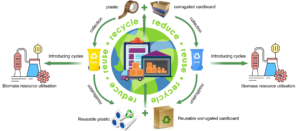Volume 19 Issue 1
Latest articles
- Reviewpp 1844-1864Ma, H., Lv, P., Wang, C., and Zhou, J. (2024). “Comprehensive treatment and disposal of logistics waste in China: Prospects of biomass resource conversion,” BioResources 19(1), 1844-1864.AbstractArticlePDF

The exponential growth of China’s economy, coupled with the surge in online commerce, has led to a significant expansion of the logistics industry. In 2022, China’s express delivery industry generated approximately 9 million tons of waste paper and 1.8 million tons of plastic. This study analyzed the current composition and utilization of logistics waste in China, with suggestions for recycling. Logistics waste can be defined as the packaging waste generated in the logistics industry. Corrugated paper and plastic waste were chosen as the objects for utilization. Due to its high cellulose content, corrugated paper can be utilized along with other paper waste for biomass resourcing. Biodegradable plastics can also be converted into biomass resources through the action of specific microorganisms. These polymers can be enzymatically depolymerized by certain bacteria and fungi, yielding valuable organic products. In general, logistics wastes all have potential for biomass resource recovery. By adopting appropriate recovery and conversion technologies, these waste streams can be transformed into high-value bio-based products, such as biofuels, biochemicals, and biopolymers, thus contributing to the development of a circular and sustainable economy.
- Reviewpp 1865-1924Das, R., Lindström, T., Khan, M., Rezaei, M., and Hsiao, B. S. (2024). “Nanocellulose preparation from diverse plant feedstocks, processes, and chemical treatments: A review emphasizing non-woods,” BioResources 19(1), 1865-1924.AbstractArticlePDF
Low-cost production of nanocellulose from diverse lignocellulosic feedstocks has become an important topic for developing sustainable nanomaterials. The available feedstocks include both woody and non-woody plants, where the latter are relatively underutilized. Interestingly, the porous structure and low lignin content in most non-woody plants, such as agricultural residues and natural fibers, also makes them ideal sources for lower energy nanocellulose production using simpler methods than those required to process woody plants. To enhance the goal of circularity, this review first provides an overview of the nanocellulose conversion from cellulose and then comprehensively discusses the use of non-woody feedstocks for nanocellulose production. Specifically, the availability of suitable non-woody feedstocks and the use of low-cost processes for pulping and cellulose oxidation treatments, including alkaline, solvent pulping, and nitrogen-oxidation treatments, are discussed. The information in this review can lead to new opportunities to achieve greater sustainability in biobased economies. Additionally, demonstrations of nanocellulose-based water purification technologies using agricultural residues derived remediation materials are highlighted at the end of this review.
- Reviewpp 1925-2002Hubbe, M. A. (2024). “Size press practices and formulations affecting paper properties and process efficiency: A Review,” BioResources 19(1), 1925-2002.AbstractArticlePDF
Size presses on paper machines are used to apply a solution of a polymer – usually starch – to the surface of the sheet and thereby to increase the stiffness, surface strength, and printing quality of the product. This article reviews publications dealing with the size press equipment, the materials, and factors affecting both the operating efficiency and attributes of the resulting paper. The emergence of film-press equipment (e.g. blade-metering size presses) in the 1980s has greatly decreased the frequency of web breaks and increased productivity. Starch technology at the size press, though relatively mature, continues to evolve. By adjustment of starch attributes, solids levels, and incorporating other additives, modern papermakers can tune size press outcomes to meet a range of paper product requirements, including strength, hydrophobicity, and the reduction of air permeability. By application of various synthetic polymers, mineral particles, and even nanocellulose in combination with starch or other base polymers, there is potential to extend the technology to meet a range of future needs for paper products.
